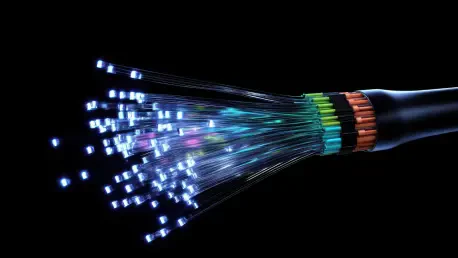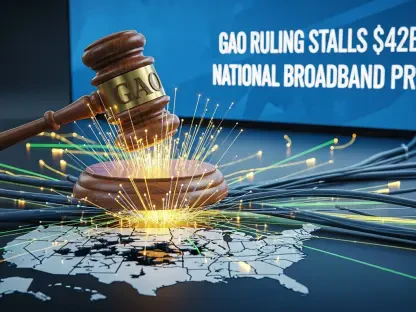Polymer Optical Fiber (POF) is experiencing unprecedented growth and innovation in the current technological landscape. As high-speed data transmission becomes increasingly essential, POF offers a viable solution, addressing needs across multiple industries, including the Internet of Things (IoT) and automotive sectors. With its market trajectory pointing to a valuation of USD 5.2 billion by 2032 and an expected Compound Annual Growth Rate (CAGR) of 9.49% from 2025 to 2032, POF stands at the forefront of fiber communication advancements. This surge is driven not only by its technical advantages but also by its strategic positioning as an alternative to traditional glass optical fibers.
Driving Forces Behind Market Growth
Demand in Emerging Technologies
Fiber optic communication systems are crucial for short-distance, high-speed data transmission, and their increased adoption is a notable contributor to POF’s market expansion. The ease of installation and cost-effectiveness of POFs make them ideal for such applications. Smart homes, with technologies requiring quick, reliable data relay, leverage POFs for their robust and flexible nature. This aspect, along with immunity to electromagnetic interference, enhances POF’s appeal in numerous applications. As more devices interconnect, the ability for seamless, low-latency communication becomes paramount, positioning POF as a pivotal component in modern networking solutions.
Furthermore, POFs are gaining traction within the automotive sector, particularly in Advanced Driver Assistance Systems (ADAS) and in-car infotainment systems. Vehicles today demand sophisticated communication infrastructure; thus, POFs, known for their short-range capabilities and ease of integration, become highly attractive. The shift towards electric and autonomous vehicles further necessitates efficient data communication solutions, where POFs offer a competitive edge thanks to their lightweight nature and superior safety profile in comparison to copper cables.
Market Segmentation and Application Domains
The POF market is classified into categories based on type, application, and end-user, offering a comprehensive perspective of its diverse applications. Types encompass PMMA (Polymethyl methacrylate), PC (Polycarbonate), and other polymer-based fibers; PMMA fibers dominate due to their superior transparency and manageable properties. Sector-wise, while the automotive industry holds a substantial share, burgeoning interest in industrial automation reveals additional growth segments for POFs. Industries worldwide are adopting automation, leveraging POF’s EMI-free nature and flexibility across environments, highlighting its indispensable role.
Telecommunications and medical sectors are also notable markets. In telecommunications, POFs facilitate robust home and office networking solutions, increasing data capacity while keeping costs manageable. The medical field uses POF in diagnostic tools and patient monitoring systems, emphasizing precision and reliability. This diverse application base exemplifies POF’s versatility and adaptability, affirming its potential in various innovative contexts and ensuring its ongoing marketplace integration and prominence.
Innovators Bridging Technology Gaps
Key Industry Players
As the POF market evolves, industry leaders such as Asahi Kasei Corporation, Toray Industries, Inc., and the Mitsubishi Chemical Group are significantly influencing its progress. These companies’ focus on innovation encompasses developing POFs with enhanced resilience and efficiency, essential for maintaining competitive advantage. Through strategic partnerships, they foster groundbreaking advancements, setting new benchmarks for performance in POF technology. For instance, collaborations between original equipment manufacturers (OEMs) and POF producers underscore the market’s trend towards integrated solutions, further propelling its wide adoption.
Additionally, specialized companies like TE Connectivity and KDPOF S.A. contribute to the industry by focusing on niche applications and entering new markets with advanced offerings. By innovating in areas such as automotive-grade fiber optics and high-resolution infotainment systems, they pave the way for other market players. Their efforts align with global trends emphasizing smart technologies, ensuring the POF market caters to emerging consumer demands and industrial requirements effectively. This synergy between innovation and market demand is vital in sustaining long-term growth dynamics.
Collaboration and Technological Advancements
Collaboration within the POF industry extends into technology integrations, exemplified by recent investments and engineering developments. The European Union’s Horizon research funding supports these ventures by enabling exploratory projects with high-precision applications, driving POF technologies into new territories. For example, in electric vehicles, fiber optic Ethernet systems improve data management efficiency, enhancing both safety features and passenger experiences. Such integrations depict the prevailing trend towards omnipresent connectivity solutions, fueled by industry-wide cooperation and research-backed strategies.
Major technological breakthroughs further reinforce this momentum. TE Connectivity’s release of durable, thermally resistant automotive-grade POFs highlights emerging needs for robust materials suited for challenging environments. Similarly, KDPOF’s introduction of a cutting-edge POF chipset marks a leap towards low-latency, high-bandwidth capabilities tailored for modern infotainment systems. As more companies venture into uncharted POF territories, these advancements signify broader applications and integration into smart infrastructure projects and burgeoning markets worldwide.
Navigating Challenges and Opportunities
Overcoming Technical Barriers
Despite its advantages, POF must navigate several challenges to maintain its growth trajectory. One primary hurdle is overcoming the limitations in transmission distances, as POFs are primarily efficient over shorter spans. This constraint demands innovative solutions to extend reach without compromising speed or integrity. Additionally, price competition from glass fiber optics remains a persistent pressure, emphasizing the need for cost-effective POF development that balances affordability with enhanced functionality. Future breakthroughs in hybrid fiber technology could mitigate these issues, unlocking new avenues for practical application.
The market’s resilience also hinges on maintaining performance standards while broadening application scopes. As industries delve deeper into digital transformations, data communication solutions must evolve, dovetailing with POF’s unique attributes. Companies are investing in research and development to enhance signal integrity, bandwidth capabilities, and other functional parameters vital for competitive viability. Addressing these challenges strategically ensures continued relevance and adoption, sustaining POF’s momentum through adaptive strategies and technological evolution.
Regional Dynamics and Market Penetration
Geographic market dynamics further influence POF’s growth trajectory, with regions like Asia-Pacific and North America playing pivotal roles. In Asia-Pacific, countries such as China, Japan, and South Korea lead due to their advanced electronics manufacturing capabilities and supportive governmental policies on fiber optic infrastructure development. This environment fosters a competitive edge and accelerates POF’s integration across consumer electronics and automotive spheres. Meanwhile, North America’s strength lies in its robust automotive and healthcare industries, which employ POF for its high data throughput and safety profiles.
Europe, particularly Germany and France, advances POF integration through Industry 4.0 initiatives, promoting digitization and smart factory concepts. The emergence of POF infrastructure in Latin America and the Middle East & Africa illustrates market growth potential as connectivity demands rise. Establishing a presence in these emerging areas can bolster POF’s global market position, emphasizing its universal applicability. Strategic regional initiatives not only solidify market footholds but also catalyze further innovations addressing specific local requirements and preferences.
Prospects and Future Directions
Innovation and Ecosystem Expansion
The outlook for POF technology solidifies around advancements in automotive electronics, smart building ideation, and industrial automation. These sectors spearhead the demand for POF’s low-latency, high-bandwidth characteristics imperative for seamless data interaction. As the 5G and IoT ecosystems evolve, they further amplify these drivers, creating prerequisites for novel POF applications. Staying ahead in these transformative areas will demand continuous investment in cutting-edge research and industry partnerships.
Aside from sector-specific growth, broad factors like government support for innovation form a substantial backbone for POF advancements. Countries investing in high-speed, fiber-based national infrastructure establish competitive marketplaces, ensuring that POF remains an integral component of future networks. R&D initiatives, powered by both public funding and private investment, are essential for propelling technologies towards more adaptive, scalable solutions meeting burgeoning global demands.
Strategic Pathways for Expansion
Moving forward, the POF market’s landscape will likely include incrementally adaptive strategies addressing complex technological demands. The emergence of novel polymers and hybrid fiber systems with enhanced attributes signals a pivotal transition towards versatile, multi-functional communication mediums. Simultaneously, collaborations among industry stalwarts foster an environment conducive to shared learning and technological progression. These factors yield sustainable, scalable growth trajectories aligning with future market needs.
Reflecting on these developments, POF technology is poised for ongoing transformation and expansion, responding strategically to opportunities where connectivity and efficiency interconnect. The complex web of industry collaborations, cross-sector applications, and supportive infrastructure initiatives highlights its criticality in the communication paradigms of tomorrow. With continuous innovation, POF’s relevance and contribution to technological advancements chart a promising path forward.
Conclusion
Polymer Optical Fiber (POF) is currently witnessing remarkable growth and innovation within the technological sphere. As the demand for high-speed data transmission escalates, POF emerges as a promising solution, meeting requirements in various fields such as the Internet of Things (IoT) and automotive industries. The market for POF is projected to reach an impressive valuation of USD 5.2 billion by 2032, with a favorable Compound Annual Growth Rate (CAGR) of 9.49% from 2025 to 2032. This upward trend solidifies POF’s position as a leader in fiber communication advancements. The increasing adoption and success of POF technology aren’t solely due to its technical prowess but also its strategic role as an efficient alternative to conventional glass optical fibers. POF is appreciated for its flexibility, ease of installation, and costs, making it attractive across sectors. As technology continues to evolve, POF’s role will likely expand, cementing its influence in the fiber optics realm and beyond.









